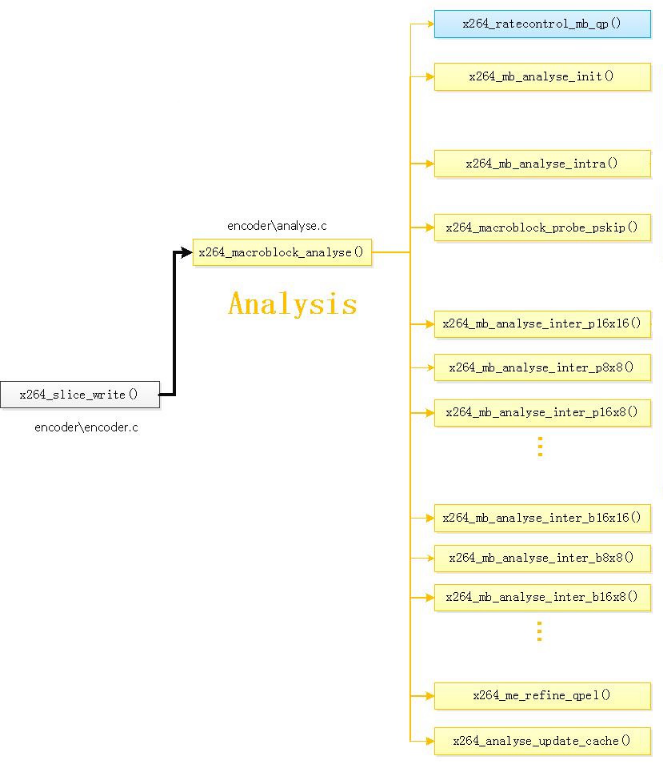x264代码剖析(十一):核心算法之宏块分析函数x264_macroblock_analyse()
x264的 x264_slice_write()函数中调用了宏块分析函数x264_macroblock_analyse(),该模块主要完成2大任务:一是对于帧内宏块,分析帧内预测模式;二是对于帧间宏块,进行运动估计,分析帧间预测模式。
如下图所示是x264_macroblock_analyse()的函数关系图。
从图中可以总结出x264_macroblock_analyse()函数调用了如下几个主要的函数:
x264_ratecontrol_mb_qp( ):通过码率控制方法获取本宏块QP
x264_mb_analyse_init():Analysis模块初始化。
x264_mb_analyse_intra():Intra宏块帧内预测模式分析。
x264_macroblock_probe_pskip():分析是否是skip模式。
x264_mb_analyse_inter_p16x16():P16x16宏块帧间预测模式分析。
x264_mb_analyse_inter_p8x8():P8x8宏块帧间预测模式分析。
x264_mb_analyse_inter_p16x8():P16x8宏块帧间预测模式分析。
x264_mb_analyse_inter_b16x16():B16x16宏块帧间预测模式分析。
x264_mb_analyse_inter_b8x8():B8x8宏块帧间预测模式分析。
x264_mb_analyse_inter_b16x8():B16x8宏块帧间预测模式分析。
x264_macroblock_analyse()用于分析宏块的预测模式。该函数的定义位于encoder\analyse.c,对应的代码分析如下:
/******************************************************************/
/******************************************************************/
/*
======Analysed by RuiDong Fang
======Csdn Blog:http://blog.csdn.net/frd2009041510
======Date:2016.03.13(今天当舅舅啦!!!哈哈哈)
*/
/******************************************************************/
/******************************************************************/
/************====== x264_macroblock_analyse()函数 ======************/
/*
功能:分析函数,调用了帧内预测与帧间预测
*/
/*****************************************************************************
* x264_macroblock_analyse:
*****************************************************************************/
void x264_macroblock_analyse( x264_t *h )
{
x264_mb_analysis_t analysis;
int i_cost = COST_MAX;
h->mb.i_qp = x264_ratecontrol_mb_qp( h ); ///通过码率控制方法,获取本宏块QP
/* If the QP of this MB is within 1 of the previous MB, code the same QP as the previous MB,
* to lower the bit cost of the qp_delta. Don't do this if QPRD is enabled. */
if( h->param.rc.i_aq_mode && h->param.analyse.i_subpel_refine < 10 )
h->mb.i_qp = abs(h->mb.i_qp - h->mb.i_last_qp) == 1 ? h->mb.i_last_qp : h->mb.i_qp;
if( h->param.analyse.b_mb_info )
h->fdec->effective_qp[h->mb.i_mb_xy] = h->mb.i_qp; /* Store the real analysis QP. */
x264_mb_analyse_init( h, &analysis, h->mb.i_qp ); ///Analysis模块初始化
/*--------------------------- Do the analysis ---------------------------*/
/*******************************************************/
/*
I帧:只使用帧内预测,分别计算亮度16x16(4种)和4x4(9种)所有模式的代价值,选出代价最小的模式
*/
/*******************************************************/
if( h->sh.i_type == SLICE_TYPE_I )
{
//I slice
//通过一系列帧内预测模式(16x16的4种,4x4的9种)代价的计算得出代价最小的最优模式
intra_analysis:
if( analysis.i_mbrd )
x264_mb_init_fenc_cache( h, analysis.i_mbrd >= 2 );
//帧内预测分析
//从16×16的SAD,4个8×8的SAD和,16个4×4SAD中选出最优方式
x264_mb_analyse_intra( h, &analysis, COST_MAX ); ///Intra宏块帧内预测模式分析
if( analysis.i_mbrd )
x264_intra_rd( h, &analysis, COST_MAX );
//分析结果(开销)都存储在analysis结构体中
i_cost = analysis.i_satd_i16x16;
h->mb.i_type = I_16x16;
//如果I4x4或者I8x8开销更小的话就拷贝
//copy if little
COPY2_IF_LT( i_cost, analysis.i_satd_i4x4, h->mb.i_type, I_4x4 );
COPY2_IF_LT( i_cost, analysis.i_satd_i8x8, h->mb.i_type, I_8x8 );
//画面极其特殊的时候,才有可能用到PCM
if( analysis.i_satd_pcm < i_cost )
h->mb.i_type = I_PCM;
else if( analysis.i_mbrd >= 2 )
x264_intra_rd_refine( h, &analysis );
}
/*******************************************************/
/*
P帧:计算帧内模式和帧间模式( P Slice允许有Intra宏块和P宏块;同理B帧也支持Intra宏块)。
对P帧的每一种分割进行帧间预测,得到最佳的运动矢量及最佳匹配块。
帧间预测过程:选出最佳矢量——>找到最佳的整像素点——>找到最佳的二分之一像素点——>找到最佳的1/4像素点
然后取代价最小的为最佳MV和分割方式
最后从帧内模式和帧间模式中选择代价比较小的方式(有可能没有找到很好的匹配块,这时候就直接使用帧内预测而不是帧间预测)。
*/
/*******************************************************/
else if( h->sh.i_type == SLICE_TYPE_P )
{
int b_skip = 0;
h->mc.prefetch_ref( h->mb.pic.p_fref[0][0][h->mb.i_mb_x&3], h->mb.pic.i_stride[0], 0 );
analysis.b_try_skip = 0;
if( analysis.b_force_intra )
{
if( !h->param.analyse.b_psy )
{
x264_mb_analyse_init_qp( h, &analysis, X264_MAX( h->mb.i_qp - h->mb.ip_offset, h->param.rc.i_qp_min ) );
goto intra_analysis;
}
}
else
{
/* Special fast-skip logic using information from mb_info. */
if( h->fdec->mb_info && (h->fdec->mb_info[h->mb.i_mb_xy]&X264_MBINFO_CONSTANT) )
{
if( !SLICE_MBAFF && (h->fdec->i_frame - h->fref[0][0]->i_frame) == 1 && !h->sh.b_weighted_pred &&
h->fref[0][0]->effective_qp[h->mb.i_mb_xy] <= h->mb.i_qp )
{
h->mb.i_partition = D_16x16;
/* Use the P-SKIP MV if we can... */
if( !M32(h->mb.cache.pskip_mv) )
{
b_skip = 1;
h->mb.i_type = P_SKIP;
}
/* Otherwise, just force a 16x16 block. */
else
{
h->mb.i_type = P_L0;
analysis.l0.me16x16.i_ref = 0;
M32( analysis.l0.me16x16.mv ) = 0;
}
goto skip_analysis;
}
/* Reset the information accordingly */
else if( h->param.analyse.b_mb_info_update )
h->fdec->mb_info[h->mb.i_mb_xy] &= ~X264_MBINFO_CONSTANT;
}
int skip_invalid = h->i_thread_frames > 1 && h->mb.cache.pskip_mv[1] > h->mb.mv_max_spel[1];
/* If the current macroblock is off the frame, just skip it. */
if( HAVE_INTERLACED && !MB_INTERLACED && h->mb.i_mb_y * 16 >= h->param.i_height && !skip_invalid )
b_skip = 1;
/* Fast P_SKIP detection */
else if( h->param.analyse.b_fast_pskip )
{
if( skip_invalid )
// FIXME don't need to check this if the reference frame is done
{}
else if( h->param.analyse.i_subpel_refine >= 3 )
analysis.b_try_skip = 1;
else if( h->mb.i_mb_type_left[0] == P_SKIP ||
h->mb.i_mb_type_top == P_SKIP ||
h->mb.i_mb_type_topleft == P_SKIP ||
h->mb.i_mb_type_topright == P_SKIP )
b_skip = x264_macroblock_probe_pskip( h ); ///分析是否是skip模式--P
}
}
h->mc.prefetch_ref( h->mb.pic.p_fref[0][0][h->mb.i_mb_x&3], h->mb.pic.i_stride[0], 1 );
if( b_skip )
{
h->mb.i_type = P_SKIP;
h->mb.i_partition = D_16x16;
assert( h->mb.cache.pskip_mv[1] <= h->mb.mv_max_spel[1] || h->i_thread_frames == 1 );
skip_analysis:
/* Set up MVs for future predictors */
for( int i = 0; i < h->mb.pic.i_fref[0]; i++ )
M32( h->mb.mvr[0][i][h->mb.i_mb_xy] ) = 0;
}
else
{
const unsigned int flags = h->param.analyse.inter;
int i_type;
int i_partition;
int i_satd_inter, i_satd_intra;
x264_mb_analyse_load_costs( h, &analysis );
x264_mb_analyse_inter_p16x16( h, &analysis ); ///16x16 帧间预测宏块分析--P
if( h->mb.i_type == P_SKIP )
{
fo







 本文深入剖析x264编码器中的x264_macroblock_analyse()函数,详述其在帧内预测与帧间预测中的作用,包括调用的各个子函数如帧内预测模式分析、运动估计等,阐述宏块分析的逻辑流程。
本文深入剖析x264编码器中的x264_macroblock_analyse()函数,详述其在帧内预测与帧间预测中的作用,包括调用的各个子函数如帧内预测模式分析、运动估计等,阐述宏块分析的逻辑流程。

 最低0.47元/天 解锁文章
最低0.47元/天 解锁文章

















 1万+
1万+

 被折叠的 条评论
为什么被折叠?
被折叠的 条评论
为什么被折叠?








